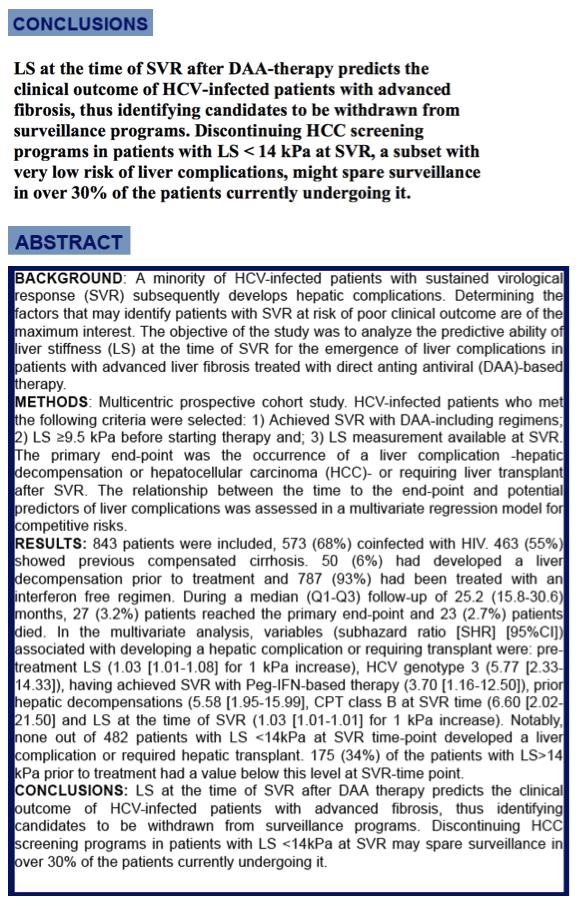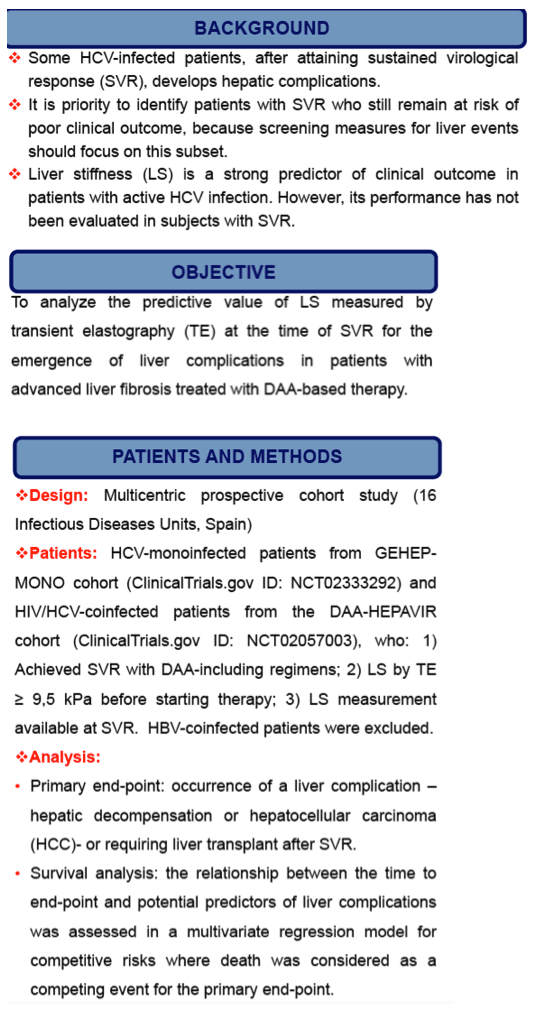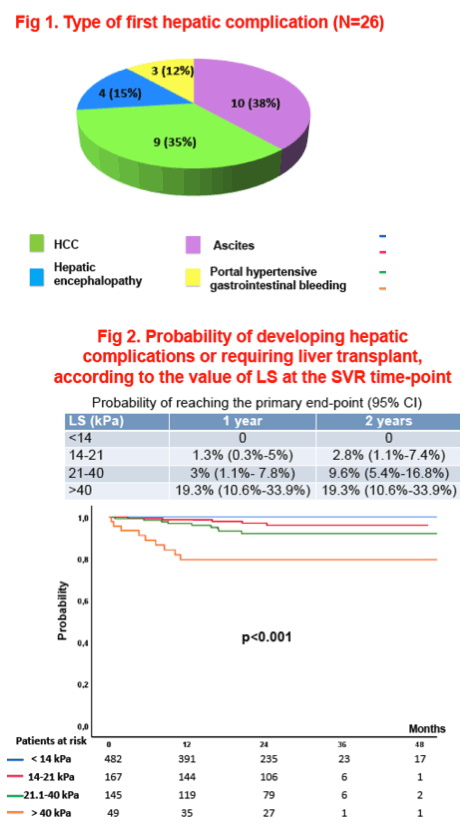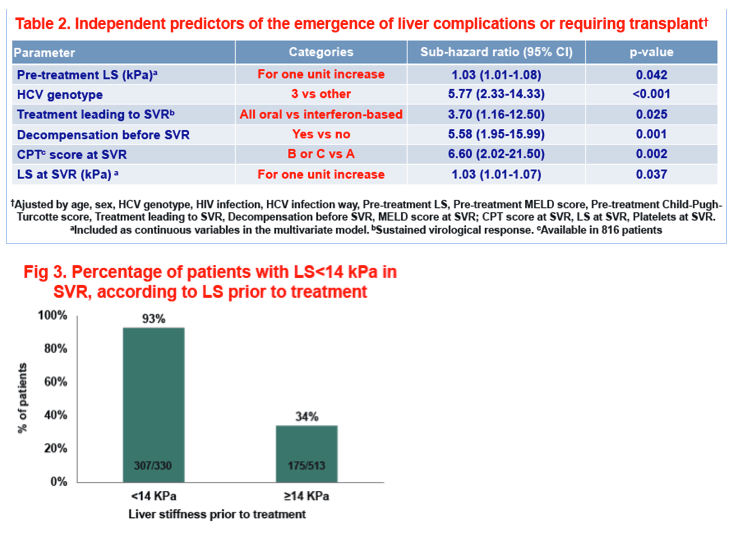 |
 |
 |
| |
Liver stiffness at SVR predicts hepatic complications in HCV-infected patients
|
| |
| |
perhaps most importantly to patients, study finds that the lower the Fibrocan or Liver Stiffness score the less risk one has for developing HCC after SVR. Jules
Reported by Jules Levin
CROI 2019 March 4-7 Seattle
Anaïs Corma-Gómez(1), María Iglesias(1), Francisco Téllez(2), Luis Morano(3), Antonio Rivero-Juárez(4), Mª José Ríos(5), Marta Santos(6), Francisco Vera(7), Jesús Santos(8), Rafael Granados(9), Dolores Merino(10) , Ignacio de los Santos(11), Juan Macías(1), Juan A. Pineda(1).
(1)Hospital Universitario de Valme, Sevilla, Spain, (2)Hospital Universitario Puerto Real, Cádiz, Spain, (3)Hospital Universitario Álvaro Cunqueiro, Vigo, Spain, (4)Instituto Maimonides de Investigación Biomédica de Córdoba (IMIBIC),Córdoba, Spain, (5)Hospital Universitario Virgen de la Macarena, Sevilla, Spain, (6)Hospital de Jerez, Jerez de la Frontera, Spain, (7)Hospital Universitario Santa Lucía, Cartagena, Spain, (8)Hospital Universitario Virgen de la Victoria, Málaga, Spain, (9)Hospital Universitario de Gran Canaria Dr Negrín, Gran Canaria, Spain, (10)Complejo Hospitalario Universitario de Huelva, Huelva, Spain, (11)Hospital Universitario La Princesa, Madrid, Spain. On behalf of the Grupo para el Estudio de las Hepatitis Víricas (GEHEP), Sociedad Española de Enfermedades Infecciosas y Microbiología Clínica. Project GEHEP 011.
from Jules: study finds that the lower the Fibrocan or Liver Stiffness score the less risk one has for developing HCC after SVR. However, continuing HCC surveillance despite low LS score can detect other liver diseases that can be present besides HCC, o not doing MRI even if Fibroscan is Low & good score wold prevent you from detecting other liver diseases that might cause death.

Abstract Body:
A minority of HCV-infected patients with sustained virological response (SVR) subsequently develops hepatic complications. Determining the factors that may identify patients with SVR at risk of poor clinical outcome are of the maximum interest. The objective of the study was to analyze the predictive ability of liver stiffness (LS) at the time of SVR for the emergence of liver complications in patients with advanced liver fibrosis treated with direct anting antiviral (DAA)-based therapy.
Multicentric prospective cohort study. HCV-infected patients who met the following criteria were selected: 1) Achieved SVR with DAA-including regimens; 2) LS ≥9.5 kPa before starting therapy and; 3) LS measurement available at SVR. The primary end-point was the occurrence of a liver complication -hepatic decompensation or hepatocellular carcinoma (HCC)- or requiring liver transplant after SVR. The relationship between the time to the end-point and potential predictors of liver complications was assessed in a multivariate regression model for competitive risks.
843 patients were included, 573 (68%) coinfected with HIV. 463 (55%) showed previous compensated cirrhosis. 50 (6%) had developed a liver decompensation prior to treatment and 787 (93%) had been treated with an interferon-free regimen. During a median (Q1-Q3) follow-up of 25.2 (15.8-30.6) months, 27 (3.2%) patients reached the primary end-point and 23 (2.7%) patients died. In the multivariate analysis, variables (subhazard ratio [SHR] [95% CI]) associated with developing a hepatic complication or requiring transplant were: pretreatment LS (1.03 [1.01-1.08] for 1 kPa increase), HCV genotype 3 (5.77 [2.33-14.33]), having achieved SVR with Peg-IFN-based therapy (3.70 [1.16-12.50]), prior hepatic decompensations (5.58 [1.95-15.99], CPT class B at SVR time (6.60 [2.02-21.50] and LS at the time of SVR (1.03 [1.01-1.01] for 1 kPa increase). Notably, none out of 482 patients with LS <14kPa at SVR time-point developed a liver complication or required hepatic transplant. 175 (34%) of the patients with LS>14 kPa prior to treatment had a value below this level at SVR-time point.
LS at the time of SVR after DAA therapy predicts the clinical outcome of HCV-infected patients with advanced fibrosis, thus identifying candidates to be withdrawn from surveillance programs. Discontinuing HCC screening programs in patients with LS <14kPa at SVR may spare surveillance in over 30% of the patients currently undergoing it.




|
| |
|
 |
 |
|
|